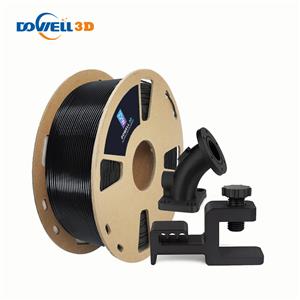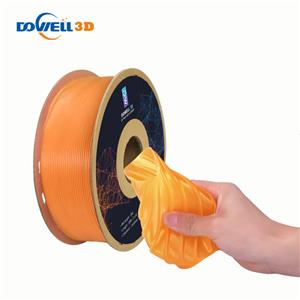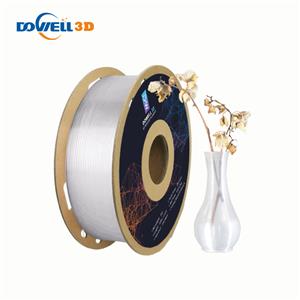Characteristics of PETG Filament
Dowell supplies high quality 3d filament, 3d printing material, PETG Filament,PLA Filament, ABS Filament, ASA Filament,PC Filament, Carbon Fiber Filament.
PETG is a glycol-modified version of PET, a transparent amorphous plastic with a light transmittance of up to 90%. It is one of the few transparent 3D printing filaments that is basically odorless when printing and has a printability close to that of PLA+. Due to its excellent thermal characteristics and semi-rigid physical strength, it is very suitable for processing and forming. The finished product is highly transparent, so it is widely used in transparent plastic plates and cosmetic bottles.
Points to note when 3D printing PETG:
1. Platform adhesion and plugging
Non-stick platform and plug, PETG printing is very prone to these two problems at the same time. Because the hot-melt extruded PETG is more viscous, if the leveling distance is not well controlled, the extruded wire will wind up on the nozzle and block the nozzle. Therefore, printing PETG requires a closer distance between the nozzle and the hot bed. At the same time, hot bed treatments such as PEI boards, glue sticks, and textured paper are required to improve the adhesion of the hot bed.
2. Overcooling stratification
Due to the better thermal properties of PETG, it is easier to cool. Therefore, if a closed 3D printer is not used or the temperature of the hot bed is insufficient, it is easy to cause the extruded wire to cool rapidly and fail to bond with the next layer, resulting in delamination.
3, fine wire drawing
Basically, everyone who tries to print for the first time will have a problem: a lot of fine wires are produced on the model, which is also caused by the viscous characteristics of PETG. To prevent this problem, the withdrawal settings of the material need to be precisely calibrated with the aid of a drawing test phantom, so it is important to adjust the retraction distance and retraction speed for best results. It is also possible to set the "coast" parameter, which works by reducing the pressure in the nozzle before the end of the dry walk. This way, when moving to the next section, there is less pressure in the nozzle, so you are less likely to see stringing and weeping during the move.
4. Wire storage
PETG wire has strong water absorption and is more likely to deteriorate when exposed to the air, so it is recommended to keep it sealed and dry. For damp PETG, it can be dried in a dryer at 60°C for reuse, but the probability of plugging will still increase.
5. Enhance light transmittance
First of all, we need to understand that the light transmittance of high-transparency items comes from the high uniformity of its constituent materials. Therefore, in order to obtain a high-transparency 3D printing model, we need to do 3 things: ① 100% filling without any gaps; ② Slightly increase the extrusion amount to fully squeeze the model material; ③ Polish the model surface .
6. Defects of changing layers
When printing at higher temperatures, small pits or bumps are easily produced on the surface of the model. These defects are generated at the layer change, the extruder suddenly starts or stops extrusion, and due to the viscosity of the consumables, it is not easy to control the extrusion, and it will be excessive or missing. The effect can be improved by modifying the printing temperature and the "length of outer wall wiping nozzle" parameter.




